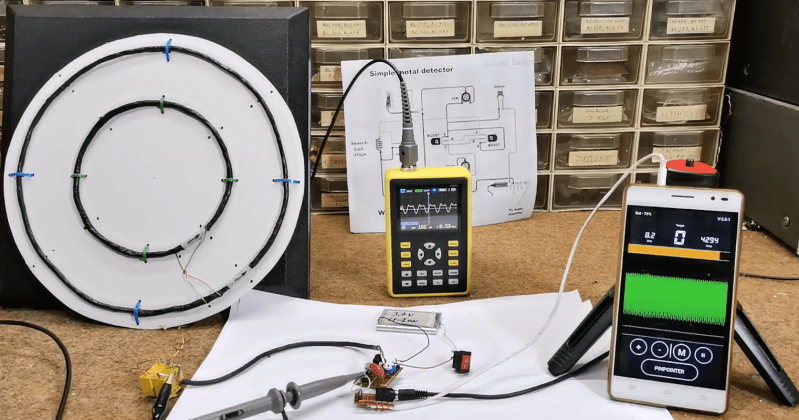[mircemk] is quite a wizard when it comes to using coils of wires in projects, especially when their application is within easy-to-build metal detectors. There are all kinds of ways to send signals through coiled wire to detect metal objects in the ground, and today [mircemk] is demonstrating a new method he is experimenting with which uses a smartphone to detect the frequency changes generated by the metal detector.
Like other metal detectors, this one uses two coils of wire with an oscillator circuit and some transistors. The unique part of this build, though, is how the detector alerts the user to a piece of metal. Normally there would be an audible alert as the frequencies of the circuit change when in the presence of metal, but this one uses a smartphone to analyze the frequency information instead. The circuit is fed directly into the headphone jack on the smartphone and can be calibrated and used from within an Android app.
Not only can this build detect metal, but it can discriminate between different types of metal. [mircemk] notes that since this was just for experimentation, it needs to be calibrated often and isn’t as sensitive as others he’s built in the past. Of course this build also presumes that your phone still has a headphone jack, but we won’t dig up that can of worms for this feature. Instead, we’ll point out that [mircemk] has shown off other builds that don’t require any external hardware to uncover buried treasure.
















So we’ve been seeing a few microcontroller spectrum analysers lately, wonder if you could leverage that code for giving you visual feedback of a contact. Then either have saved curves to compare to, “that looks like aluminum” “that looks like a bottle cap” etc.
Whoops, a hanging either…. OR… just use wetware braining and experience to pattern compare.
Programmable filters front-end with feedback from the back-end AI.
Could it be possible to later train a neural network to make the detection a little bit more Intelligent
One could use a bluetooth module and send all the info to an app. With an accelerometer you could plot out amplitude and frequency per sweep. Not sure if it’s useful or if it was done already, it just occurred to me reading the article.
Can you get high sample rate BT audio easily? because the basic crap seems to be low bitrate that would mangle your data with artifacts.
Bluetooth 5.0 supports hi def 24/96. BT is a whole family of progressing and backward compatible standards. BT MIDI is just a few years old though MIDI is early 80’s.
Yah, I mean can you get it in a cheap module, fully datasheeted, not a NDAed $200 dev board.
This is a very intelligent answer, so far
A whole additional level, but I was wondering about adding an IMU unit to the detector to try and visually map the size and location of the object as well. Something like a 30-60 sec heatmap trail?
Or strap a wiimote to it for the swingametry.
Also could use an inductive cooktop as the “search” coil and a smartphone FLIR clip-on for a literal heat map :-D
Has the optical flow sensor hype died down already? Looks like it might as well be an oversized optical mouse if the ground permits it.
Bring able to accurately measure swing speed would be an enormous boon to accurate target with representation. I have often mused on an optical sensor for this purpose. Has it been done at some stage? How would this affect the coil, would the additional inductance of the sensor be nulled out?
Not sensitive enough, try it with a ring size object.
Phone barely displays anything.
There’s still a dozen pennies in my front yard from failed field test of an old Radio Shack detector I picked up. Trouble is, it’s one of those models that serious detectorists dismiss as a toy due to low sophistication, but it’s a notch or two above toy, and should have had some functionality when new. So…. I can’t really find any useful info as to getting it working as right as it should work.